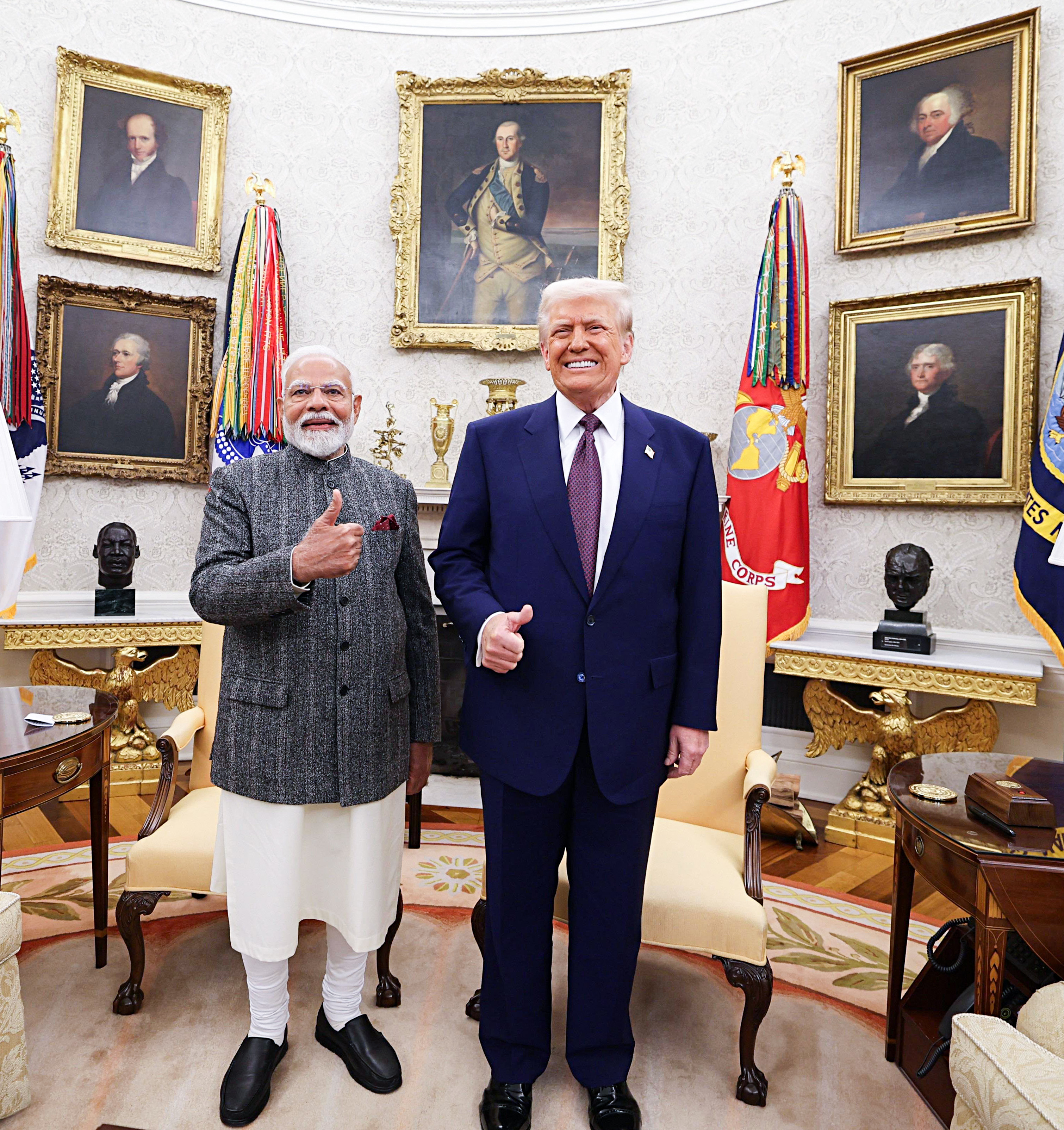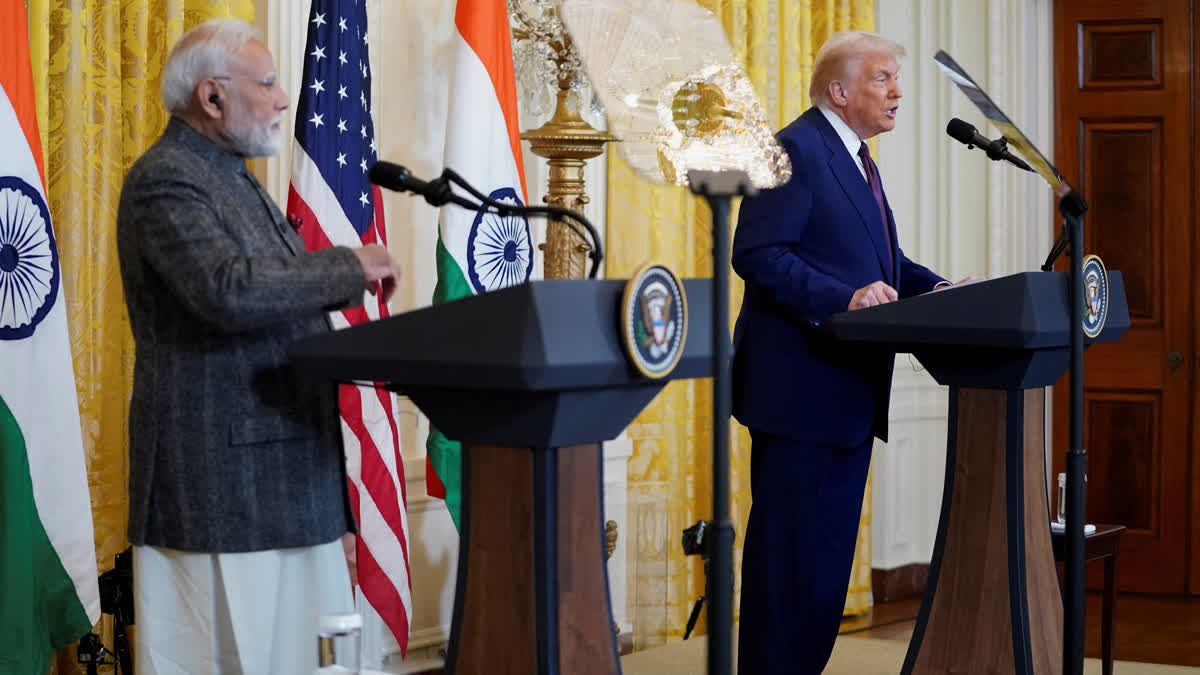By Surabhi Gupta
New Delhi: India finds itself in a safe place, at least for the moment, amid global markets bracing for the impact after US President Donald Trump's announcement of "reciprocal tariffs" taking effect from in two months time. India's trade ties with the US are vital and it needs to navigate it with caution. Tariffs have always been used as means to protect each country's industries. The measures are now being billed as instruments reshaping the economic future of two countries.
On Thursday, Trump said he would impose reciprocal tariffs, and it will take effect from April 1, 2025. And India being one of the US's largest trading partners, is said to be closely monitoring the situation for the impact it might have on its exports and long-term trade agreements.
Indian diplomat K P Fabian says both countries have set ambitious international targets to be achieved in the next five years but has a word of caution. "During the meetings between Prime Minister Modi and President Trump, they have decided to boost international trade volume between the two countries to $500 billion by 2030." Both leaders have a good personal chemistry between them and that they want to raise the trade volume, he said.
The uncertainty
"Trump’s talk of reciprocal tariffs adds a layer of uncertainty," he said, on a cautionary note, adding that there were some grey areas in reciprocal tariffs. He used Trump’s complaint about India’s tariffs on Harley-Davidson motorcycles to explain. He said a 20% tariff on Harley-Davidson bikes with engine capacities above 1600cc imposed by India can be reciprocated in the same manner if India were exporting 1600cc motorcycles to the US. What if India is exporting only 800cc motorcycles and if it attracts a 20% tariff akin to 1600cc-plus bikes would not be fair.

He also questioned the understanding of Trump on trade economics. The US president has stated that he would create an external revenue service by raising tariffs and that it would generate a good amount of money, he said. "Tariffs are internal revenue, not external. If a Californian importer buys goods from Mumbai, the buyer pays the increased tariff in California, not in Mumbai,” he reasoned.
Fabian did not agree with Trump's claims on BRICS being dead and that it was incorrect. "His claim is that BRICS wants an alternative currency. The last summit in Russia has cleared the air on that. India is not for an alternate BRICS currency as it is likely to benefit China," he said adding that India has always preferred to have bilateral currency agreements, like the one in vogue with the UAE and Russia.
The diplomat said, "The world has issues with Trump’s approach." According to him, it is better to shake hands with America than hugging it. "If you hug too tight, it may become difficult to breathe as the US does not believe in equal relationships."
What is the reciprocal tariff?
Reciprocal tariffs, in American parlance, mean that when a country announces tariffs on the US goods that it imports, then the US will reciprocate it with a similar tariff on the imports by that country. It may seem like a simple strategy and can be dubbed as a path to create a fairer trade environment. This can have a negative bearing on trade volume and the possibility of disrupting the already signed trade agreements. It will also impact on trade frameworks of the World Trade Organization (WTO).
" i am thrilled to welcome the prime minister of india, my friend @NarendraModi, back to the @WhiteHouse.
— President Donald J. Trump (@POTUS) February 14, 2025
There is truly a special bond between the United States and India—the world's oldest democracy and the world's largest democracy." –President Donald J. Trump 🇺🇸🇮🇳 @PMOIndia pic.twitter.com/CfcRUMgLWs
Less Concerned
Speaking to ETV Bharat, Foreign policy expert Suresh K Goyal said, "India shouldn't be overly concerned because even if tariffs are enacted, they probably won't have a significant impact," adding that the Indian products will get costlier in the US after the proposed tariffs. "This is not only for us. The same applies to China, our biggest competitor. So, we don’t see a significant disadvantage," he explained.
The Opportunities
Goyal asserted that Trump's trade policies can help open new avenues of trade for India. The joint-statement from Prime Minister Narendra Modi and Trump showed that the US will help India, sharing tech and supplying defence equipment. "The US has agreed to provide its certified(F-35 fighter jet) aircraft to India. They've decided to increase the bilateral trade volume to $500 billion by 2030."
"After Prime Minister Narendra Modi’s meeting with Elon Musk, it seems (the tech billionaire) is considering investing in India and to work closely with Indians. Modi's successful meeting with US National Security Advisor Waltz Michael is another positive indicator. They will collaborate on semiconductors and artificial intelligence, he said.
Goyal said a road map for technological cooperation has already been made. "A roadmap for India-US is chalked to cooperate and work together on critical, emerging, and nuclear technologies," he said, adding that the initiative will be a shot in for trade and investment in India, benefiting stakeholders in both countries.
🇺🇸🤝🇮🇳 pic.twitter.com/NJWlmHIxpT
— The White House (@WhiteHouse) February 13, 2025
India-US Economic Ties
EEPC chairman Pankaj Chadha says India and the US are strengthening their strategic relationships in defence, technology, and trade, amid growing concerns of tariffs. The Engineering Export Promotion Council (EEPC) India chief said the visit of the PM has opened the doors for a comprehensive dialogue with the US government on trade issues. This, he said, will be a win-win situation for both countries.
Ashwani Kumar, president of the Federation of Indian Export Organizations (FIEO), said the discussions during PM Modi’s visit were "pivotal in expanding trade in key sectors like technology, defence, green energy, and infrastructure."
He said, US being one of India's largest trading partners, the visit would create new opportunities for Indian exporters, lauding the projected trade volume goal. The $500 billion trade volume by 2030 is challenging but achievable.
Sanjay Nayar, president of ASSOCHAM, claimed that "the joint statement reflects the ongoing trust and the strengthening of the strategic partnership between India and the US." According to him, the visit has led to tangible outcomes. He echoed the views of Goyal as for the US-India roadmap for accelerating AI and semiconductor infrastructure development.
Mitigating The Impact Of Tariffs
Just as reciprocal tariffs pose challenges, India will engage itself to mitigate its negative effects through its diplomatic channels. The high-level meeting Modi had with influential figures like Elon Musk and Waltz Michael is an indicator on how India is planning its future technology and defence.
"Had a fruitful meeting with NSA Waltz Michael. He has always been a great friend of India. Defence, technology and security are important aspects of India-USA ties, and we had a wonderful discussion around these issues. There is strong potential for cooperation in sectors like AI, semiconductors, space and more,” PM Modi posted on X.
Had a fruitful meeting with NSA @michaelgwaltz. He has always been a great friend of India. Defence, technology and security are important aspects of India-USA ties and we had a wonderful discussion around these issues. There is strong potential for cooperation in sectors like… pic.twitter.com/5w3Gv2lMJ6
— Narendra Modi (@narendramodi) February 13, 2025
"Had a very good meeting with Elon Musk in Washington DC. We discussed various issues, including those he is passionate about such as space, mobility, technology and innovation. I talked about India’s efforts towards reform and furthering ‘Minimum Government, Maximum Governance’," the PM tweeted.
Both sides aim to finalise a Bilateral Trade Agreement (BTA) by the end of 2025. It intends to address trade barriers and facilitate smoother trade flows. Stakeholders see this to be "a crucial step toward lessening the impact of tariffs and enhancing market access" for both sides.



